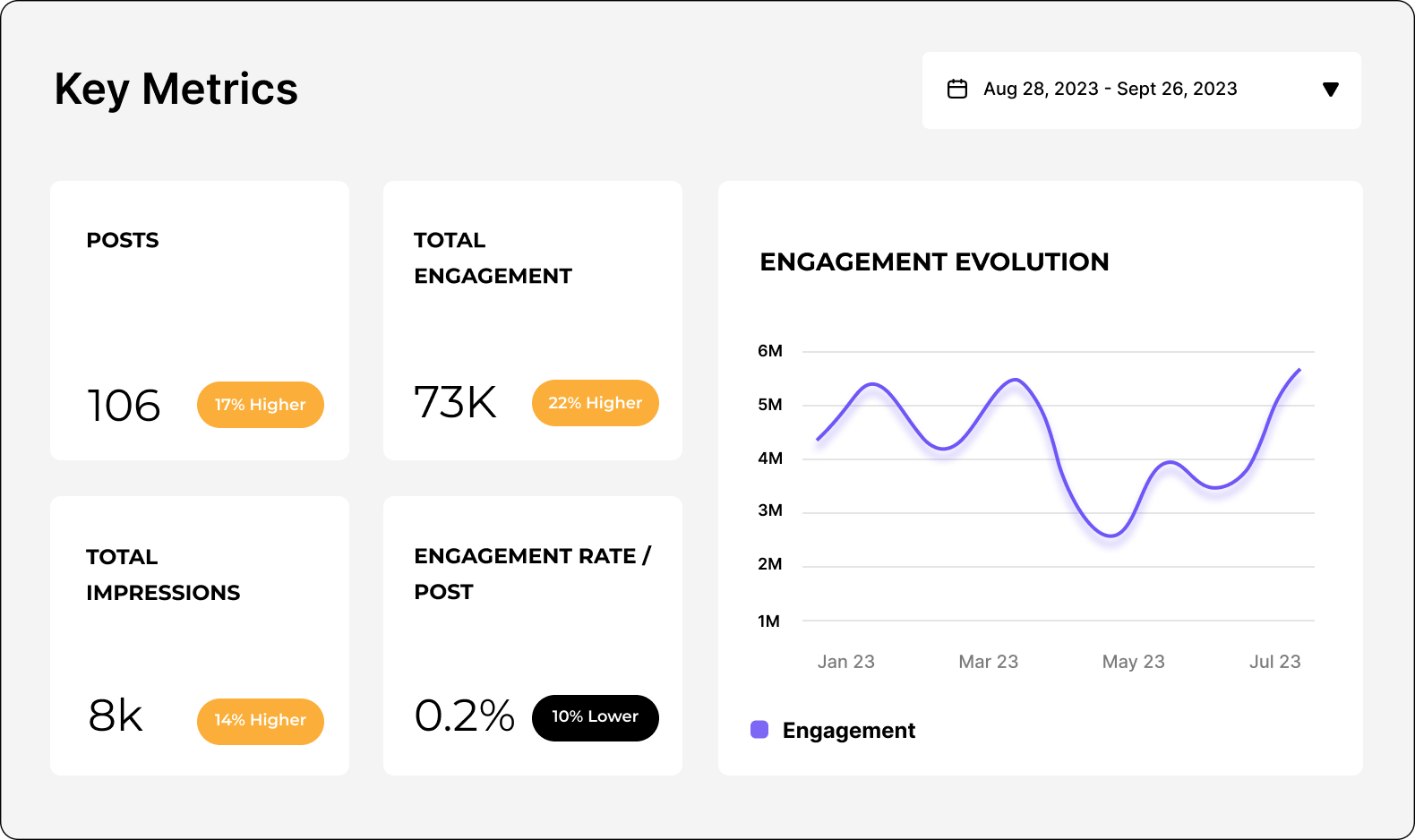FREE Head-to-Head Facebook Comparison
Understand your competitors’ social media strategy so you can outperform them
Executive Summary
🏆 Higher Engagement
HBO leads with a 0.03%% engagement rate (compared to Disney's 0.01%), which indicates stronger audience interaction.
💖 More Likes
Disney garners an average of 5,283 reactions per post, outperforming HBO's 2,902 reactions, showcasing Disney's larger passive engagement from their follower base.
💬 Comment Leaders.
HBO generates 228.98 average comments compared to Disney's 209.03, reflecting a higher level of audience discussion and content-driven conversations.
Top Performing Posts
Analysis

Avg. Posts/ Day
Measures how frequently accounts post new content on average. Higher posting frequency increases visibility but risks follower fatigue if overdone.

Avg. Engagement
Shows the average engagement received on a post through reactions, comments, and shares. Higher numbers indicate more engaging content.

Avg. Impressions
Shows the average number of impressions each post receives, indicating how well the content attracts initial viewers.

Total Followers
Represents account's audience size and potential reach. A larger following provides wider distribution but doesn't guarantee engagement.
*This analysis only takes into consideration data for the last 30 days.
Want more historical data? Sign up for a FREE 14-day trial (no credit card required!) and get Facebook analytics for the last 12 months
I want historical dataFREE Social Media Head-to-Head Comparison
How to benchmark your Facebook performance with Socialinsider
Socialinsider’s social media analytics allow you to measure and compare social media performance against competitors and industry peers.

Start by creating a trial account

Connect the profiles you manage and your competitors'

Select the time frame you want to analyze

See how you perform compared to your competitors

Analyze your Facebook performance
Easily analyze and track your Facebook metrics, conduct audits, and perform Facebook competitor analysis with Socialinsider.
FAQs about Facebook comparison
Got a question? We've got answers.
How can I compare the reach and engagement of two Facebook Pages to see which one performs better in the algorithm?
By examining both the raw numbers and these normalized rates side by side, you gain insight into not only the scale of each Page’s audience and activity, but also how effectively each Page’s content generates interactions relative to its size and visibility. High engagement rates and above-average reach per post often indicate that content is resonating well and being favored by Facebook’s algorithm, since the platform tends to reward posts that drive meaningful interactions.
To support this process, social media analytics tools like Socialinsider can automate data collection and visualization, quickly highlighting differences in performance. By focusing on these metrics and normalizing your comparison, you can confidently identify which Page is delivering stronger results and more effectively leveraging the algorithm for greater visibility and engagement.
How do I benchmark my Facebook Page against competitors to know if my reach and engagement are above or below industry standards?
After assembling these normalized metrics, analyze how your Page stacks up against competitors side-by-side. Look for patterns indicating where you outperform or lag, such as higher or lower engagement rates, average reach, or consistency of audience interaction. Additionally, reference broader industry benchmarks to see how your metrics align with typical standards in your niche or market.
Social media analytics tools like Socialinsider can simplify and automate extracting, normalizing, and visualizing these comparisons against direct competitors. For a wider context, the Socialinsider Global Brand Benchmark Directory lets you measure your results against industry or country-specific standards, providing a reliable point of reference. By leveraging these benchmarking techniques and tools, you’ll gain clear insight into your competitive position, spot strengths and weaknesses, and identify actionable areas for improvement based on well-established industry norms.
What’s the best way to compare link post performance between my Facebook Page and a competitor’s?
Normalize your findings by calculating averages per link post and engagement rates (such as clicks or interactions divided by reach or followers). This normalization allows for a fair, apples-to-apples comparison, regardless of differences in audience size or posting frequency. Examine both absolute numbers and these rate-based metrics side by side to determine which Page’s link posts generate more reach, interaction, and audience traffic.
How do I compare growth trends between two Facebook Pages to see who gains or loses followers faster?
Next, standardize these figures by calculating the percentage change in followers over each interval: [(new followers – previous followers) / previous followers] × 100. This normalization accounts for differences in Page size and lets you fairly compare growth rates, not just raw numbers. Analyzing these percentage trends side by side allows you to see not only who is gaining or losing followers more rapidly, but also spot patterns such as sustained growth, sudden spikes, or periods of loss.
How can I compare posting frequency and content mix (links, images, videos, Reels) of my Page versus competitors?
Next, calculate the posting frequency for each post type (such as posts per week or per month), as well as the overall frequency. Determine the proportion of each content type within the total content mix, so you can see which formats are prioritized by each Page. For example, you might find that your Page posts 40% images, 30% videos, 20% links, and 10% Reels, while a competitor relies more heavily on video content.
Analyze these metrics side by side to identify differences in publishing habits and content strategy. This comparison reveals content strengths, helps spot gaps (such as an underused format), and highlights frequency trends that may contribute to engagement and reach.
Ready to improve your social media strategy with real-time insights?
Get strategic insights, analyze the social performance across all channels, compare metrics from different periods, and download reports in seconds.















